Starting off spreading fertiliser on hire in the 1990s with a Ford 7840 and Bredal K65 trailed spreader, Butler Agri has since grown to be a sizeable family-run contracting business and tillage farm based in Streete, just outside Mullingar.
It is headed up by Ken Butler alongside his sons, Alex and Lewis, who both play major roles in the day-to-day operations.
All services are carried out within a 30km radius, ranging from stubble-to-stubble tillage and all the usual grassland operations such as silage, slurry, reseeding and fertiliser/lime-spreading services.
Alex explains that the business has grown within the past 15 years. “Prior to 2007, it was a one-man operation. My father Ken specialised mainly in contract fertiliser spreading for the local co-ops, Glanbia (Tirlán) and Lakeland Dairies. This, alongside slurry/muck spreading and driving for a local tillage farmer, kept him busy for the most part of the year.”
In 2007, an opportunity arose. Alex said: “Two of the neighbouring contractors at the time decided to sell up, naturally presenting us with an opportunity. There were roughly 1,200 acres of silage cutting for the taking, excluding other work. It was a now or never moment, either stay going as a one-man operation or take the plunge and expand.”
Studies
From here, the business grew and provided Alex and Lewis with the opportunity to become more involved as the years passed.
“Both myself and Lewis studied crops and machinery. I studied in Kildalton and he studied in Gurteen. I really enjoyed the course. At the time we had started tillage farming ourselves, albeit through renting land and share farming,” Alex said.
“I could put what I learnt into practice which was enjoyable and encouraging.”
Before deciding to join the family business full-time six years ago, Alex did a stint in Australia during the cereal harvest, followed by another two months last November and December.
“Australia provided me with great experience operating combines and harvest machinery, while providing a good insight into business management. It’s an experience I’d recommend to anyone.”
The business
In addition to contracting business, the family farms circa 750 acres of which 50% is rented and 50% is share-farmed. A mix of winter and spring crops are grown.
“Tillage farming is a passion of mine and a part of the business I tend to head up. Share farming so far has worked very well. It’s proved a good option for many farmers, especially those maybe not as mechanised but still want to farm. We pride ourselves in providing a good service and properly maintaining land which I think has stood to us so far.”
Alex believes that contracting alongside the tillage enterprise helps to justify some of the machinery within the fleet.
“Workload is roughly 50:50 split between tillage and grassland. Including our own work, we carry out full stubble-to-stubble operations on roughly 1,000 acres of tillage, which we can see increasing to 1,300 within the next 12 months or so.
“This includes cultivations, sowing, fertilising, spraying as well as harvesting and baling.
“We cut 2,500 acres of grass silage annually in addition to other jobs such as slurry spreading, grassland reseeding and fertiliser/lime spreading.”
In addition to Ken, Alex and Lewis, there tends to be up to five part-time workers when the season is at its busiest.
While Alex and Lewis both have their own responsibilities, Ken is very much still in charge, Alex said.
“Dad tends to do a lot of the running here and there during the busy periods and organising parts, seed, fuel, etc. Lorna, our mother, plays an active role too, cooking food for the team and helping out where possible.
“Dad also looks after invoicing while myself and himself tend to plan the day-to-day jobs.
The Butlers run a fleet of eight tractors, of which six are Fendt (three 724s, a 516 and an 828), two John Deeres (6155R and 7430) and one Valtra (T174).
With bad experience with secondhand tractors in the early years, all tractors have since been bought new at little extra cost, having taken all aspects including running costs, finance rates and resale value into account, according to Alex.
The aim is to work with a couple of key dealers.
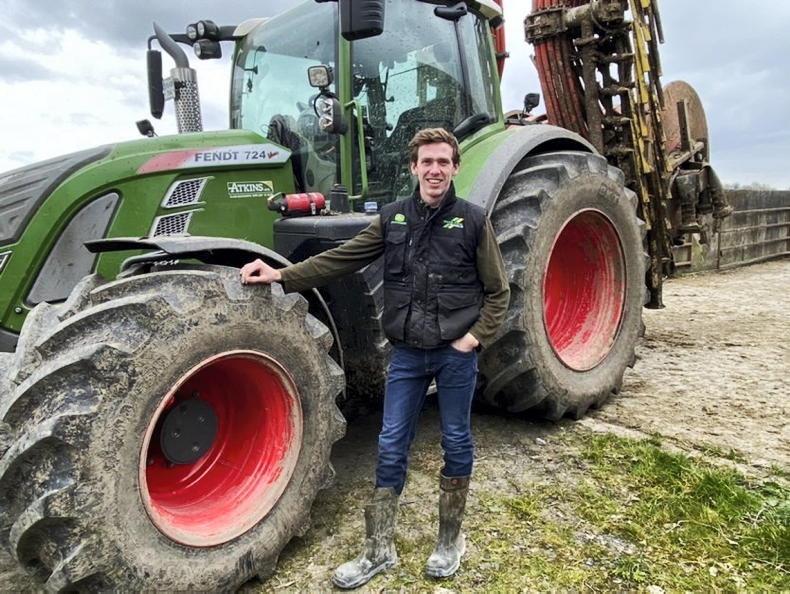
Alex Butler, Mullingar, Co Westmeath.
“Fendt tractors have performed exceptionally well for us up through the years. Although, initially more expensive than some of the competitors, the cost of ownership is where we notice the advantage. Most tractors average 1,500 hours annually. Our first Fendt has over 11,000 trouble-free hours and is still going strong. With some of the other brands we were lucky to get 6,000 hours before issues started popping up.”
Replacement policy
For years, tractors were kept to build numbers within the fleet, but the replacement policy now depends mainly on reliability and running cost.
“A tractor to us is similar to a cow on a livestock farm – if it’s not performing or if it’s giving quite a few issues then it tends to be the one replaced quickly, regardless of age.”
“In our first season out at silage in 2007, we ran a secondhand Claas Jaguar 800 series before replacing it for a new Jaguar 850 ahead of the second season. Ever since, we’ve run 850s.
“Given our size and the fact it’s only grass we are chopping, it is plenty big enough. To justify an 870, we’d need to lift an extra 300 acres annually to cover the additional costs. It’s about finding a machine that suits. Bigger isn’t always better,” Alex pointed out.
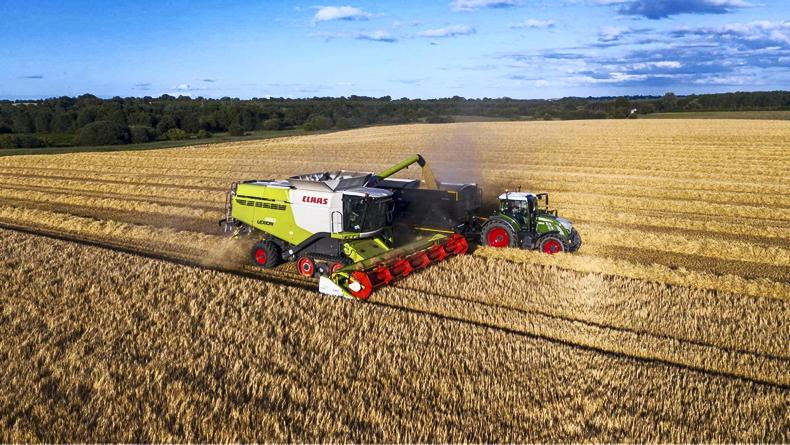
Currently over 1,000 acres are farmed from stubble-to-stubble which is expected to increase in the future.
The Butlers currently run Claas Tucano 430 and a Claas Lexion 670 TT straw walker combines which have performed well over the years. However, Alex did say that a hybrid-type rotary machine is in consideration based on increased output and the amount of straw now being chopped.
An L60G Volvo is the loading shovel of choice which the team is well impressed with.
Alongside eight-furrow and five-furrow Kverneland ploughs, the Butlers run a 3m and 4m Lemken seed drill. “We like Lemken for performance and reliability. The main downside is its running cost. Parts aren’t cheap.”
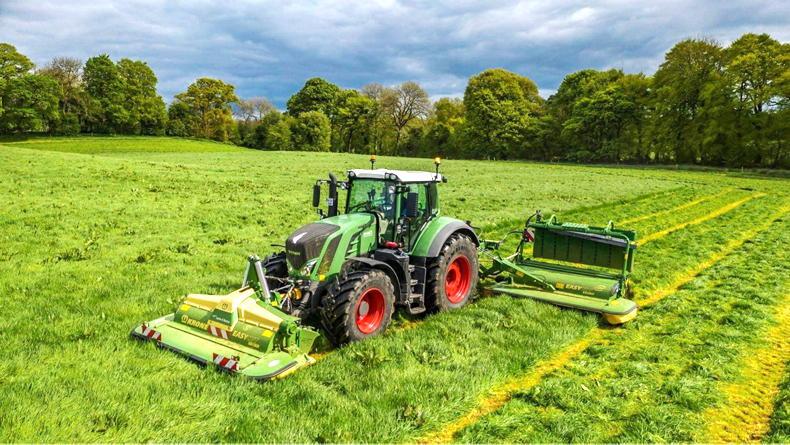
The Fendt 828 is the largest tractor in the fleet, primarily working the butterfly mowers, eight-furrow plough and 4m one pass.
On the slurry side of the business, umbilical spreading is the core service provided using a 12m twin macerator Mastek system. New for this year is the addition of a new Bredal F10 trailed fertiliser spreader which will work alongside the K series Bredal machines and 4t Bogballe-mounted spreader. Some other machines include a Claas Quadrant square baler, Krone butterfly mowers and a Krone twin-rotor rake.
“The next few years will be tough years for contractors. Primarily down to the price of machinery replacement and running costs coupled with interest rates which will undoubtedly sort the men from the boys. Staff and rates continue to be limiting factors.
“Contractors investing in their business to provide the best service and employ good staff need to be rewarded. As the old saying goes, ‘good work isn’t cheap and cheap work isn’t good’. I think, we’ll continue to see more contractors leave the sector.
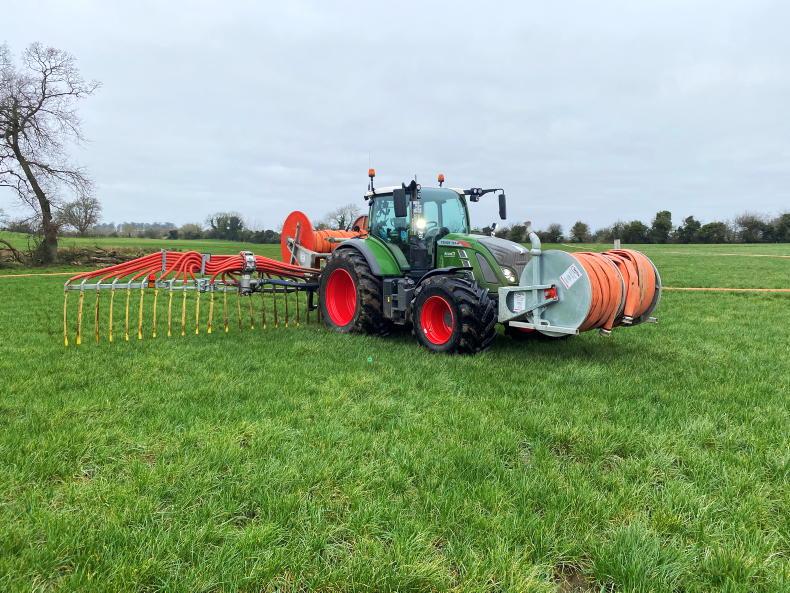
The majority of the slurry is spread using a Mastek 12m umbilical dribble bar system.
“I don’t think it would be possible for anyone now to decide to start contracting from scratch, purely down to the costs. It was different times in 2007 when Dad did. That said, those running an efficient business with modern machinery and good replacement policies and somewhat more fixed/predictable costs have a future.
“Setting your business apart from the next is important too, for example, whether it’s adding value in the form of GPS section control, variable rate, yield mapping, etc. It’s important to have the edge over the competition,” Alex stated.
“Diversification is also important. We find this with the tillage which helps avoid placing all our eggs in the one basket. Farming needs to adapt and history does repeat itself. I see good opportunity for the AD industry in Ireland, as a sort of replacement for the beet industry. Change within the industry is here, we see it with the beef sector. ”
“Farmers across sectors need to be incentivised to work together to help address common issues as they often tend to hold solutions for each other’s problems.
“Slurry exports from dairy farms to tillage farms is a good example of just one solution.
“At the moment, tillage and dairy farmers are going head to head for land which is the wrong approach. It seems dairy farmers are indirectly forced to take on more land as a result of nitrates just to stay at the same level of production, leaving them less efficient in many cases.”
SEE MORE: Alex is one of the farmers taking part in this year’s Irish Farmers Journal From the Tramlines programme if you want to follow his farming journey over the season ahead.
Starting off spreading fertiliser on hire in the 1990s with a Ford 7840 and Bredal K65 trailed spreader, Butler Agri has since grown to be a sizeable family-run contracting business and tillage farm based in Streete, just outside Mullingar.
It is headed up by Ken Butler alongside his sons, Alex and Lewis, who both play major roles in the day-to-day operations.
All services are carried out within a 30km radius, ranging from stubble-to-stubble tillage and all the usual grassland operations such as silage, slurry, reseeding and fertiliser/lime-spreading services.
Alex explains that the business has grown within the past 15 years. “Prior to 2007, it was a one-man operation. My father Ken specialised mainly in contract fertiliser spreading for the local co-ops, Glanbia (Tirlán) and Lakeland Dairies. This, alongside slurry/muck spreading and driving for a local tillage farmer, kept him busy for the most part of the year.”
In 2007, an opportunity arose. Alex said: “Two of the neighbouring contractors at the time decided to sell up, naturally presenting us with an opportunity. There were roughly 1,200 acres of silage cutting for the taking, excluding other work. It was a now or never moment, either stay going as a one-man operation or take the plunge and expand.”
Studies
From here, the business grew and provided Alex and Lewis with the opportunity to become more involved as the years passed.
“Both myself and Lewis studied crops and machinery. I studied in Kildalton and he studied in Gurteen. I really enjoyed the course. At the time we had started tillage farming ourselves, albeit through renting land and share farming,” Alex said.
“I could put what I learnt into practice which was enjoyable and encouraging.”
Before deciding to join the family business full-time six years ago, Alex did a stint in Australia during the cereal harvest, followed by another two months last November and December.
“Australia provided me with great experience operating combines and harvest machinery, while providing a good insight into business management. It’s an experience I’d recommend to anyone.”
The business
In addition to contracting business, the family farms circa 750 acres of which 50% is rented and 50% is share-farmed. A mix of winter and spring crops are grown.
“Tillage farming is a passion of mine and a part of the business I tend to head up. Share farming so far has worked very well. It’s proved a good option for many farmers, especially those maybe not as mechanised but still want to farm. We pride ourselves in providing a good service and properly maintaining land which I think has stood to us so far.”
Alex believes that contracting alongside the tillage enterprise helps to justify some of the machinery within the fleet.
“Workload is roughly 50:50 split between tillage and grassland. Including our own work, we carry out full stubble-to-stubble operations on roughly 1,000 acres of tillage, which we can see increasing to 1,300 within the next 12 months or so.
“This includes cultivations, sowing, fertilising, spraying as well as harvesting and baling.
“We cut 2,500 acres of grass silage annually in addition to other jobs such as slurry spreading, grassland reseeding and fertiliser/lime spreading.”
In addition to Ken, Alex and Lewis, there tends to be up to five part-time workers when the season is at its busiest.
While Alex and Lewis both have their own responsibilities, Ken is very much still in charge, Alex said.
“Dad tends to do a lot of the running here and there during the busy periods and organising parts, seed, fuel, etc. Lorna, our mother, plays an active role too, cooking food for the team and helping out where possible.
“Dad also looks after invoicing while myself and himself tend to plan the day-to-day jobs.
The Butlers run a fleet of eight tractors, of which six are Fendt (three 724s, a 516 and an 828), two John Deeres (6155R and 7430) and one Valtra (T174).
With bad experience with secondhand tractors in the early years, all tractors have since been bought new at little extra cost, having taken all aspects including running costs, finance rates and resale value into account, according to Alex.
The aim is to work with a couple of key dealers.

Alex Butler, Mullingar, Co Westmeath.
“Fendt tractors have performed exceptionally well for us up through the years. Although, initially more expensive than some of the competitors, the cost of ownership is where we notice the advantage. Most tractors average 1,500 hours annually. Our first Fendt has over 11,000 trouble-free hours and is still going strong. With some of the other brands we were lucky to get 6,000 hours before issues started popping up.”
Replacement policy
For years, tractors were kept to build numbers within the fleet, but the replacement policy now depends mainly on reliability and running cost.
“A tractor to us is similar to a cow on a livestock farm – if it’s not performing or if it’s giving quite a few issues then it tends to be the one replaced quickly, regardless of age.”
“In our first season out at silage in 2007, we ran a secondhand Claas Jaguar 800 series before replacing it for a new Jaguar 850 ahead of the second season. Ever since, we’ve run 850s.
“Given our size and the fact it’s only grass we are chopping, it is plenty big enough. To justify an 870, we’d need to lift an extra 300 acres annually to cover the additional costs. It’s about finding a machine that suits. Bigger isn’t always better,” Alex pointed out.

Currently over 1,000 acres are farmed from stubble-to-stubble which is expected to increase in the future.
The Butlers currently run Claas Tucano 430 and a Claas Lexion 670 TT straw walker combines which have performed well over the years. However, Alex did say that a hybrid-type rotary machine is in consideration based on increased output and the amount of straw now being chopped.
An L60G Volvo is the loading shovel of choice which the team is well impressed with.
Alongside eight-furrow and five-furrow Kverneland ploughs, the Butlers run a 3m and 4m Lemken seed drill. “We like Lemken for performance and reliability. The main downside is its running cost. Parts aren’t cheap.”

The Fendt 828 is the largest tractor in the fleet, primarily working the butterfly mowers, eight-furrow plough and 4m one pass.
On the slurry side of the business, umbilical spreading is the core service provided using a 12m twin macerator Mastek system. New for this year is the addition of a new Bredal F10 trailed fertiliser spreader which will work alongside the K series Bredal machines and 4t Bogballe-mounted spreader. Some other machines include a Claas Quadrant square baler, Krone butterfly mowers and a Krone twin-rotor rake.
“The next few years will be tough years for contractors. Primarily down to the price of machinery replacement and running costs coupled with interest rates which will undoubtedly sort the men from the boys. Staff and rates continue to be limiting factors.
“Contractors investing in their business to provide the best service and employ good staff need to be rewarded. As the old saying goes, ‘good work isn’t cheap and cheap work isn’t good’. I think, we’ll continue to see more contractors leave the sector.

The majority of the slurry is spread using a Mastek 12m umbilical dribble bar system.
“I don’t think it would be possible for anyone now to decide to start contracting from scratch, purely down to the costs. It was different times in 2007 when Dad did. That said, those running an efficient business with modern machinery and good replacement policies and somewhat more fixed/predictable costs have a future.
“Setting your business apart from the next is important too, for example, whether it’s adding value in the form of GPS section control, variable rate, yield mapping, etc. It’s important to have the edge over the competition,” Alex stated.
“Diversification is also important. We find this with the tillage which helps avoid placing all our eggs in the one basket. Farming needs to adapt and history does repeat itself. I see good opportunity for the AD industry in Ireland, as a sort of replacement for the beet industry. Change within the industry is here, we see it with the beef sector. ”
“Farmers across sectors need to be incentivised to work together to help address common issues as they often tend to hold solutions for each other’s problems.
“Slurry exports from dairy farms to tillage farms is a good example of just one solution.
“At the moment, tillage and dairy farmers are going head to head for land which is the wrong approach. It seems dairy farmers are indirectly forced to take on more land as a result of nitrates just to stay at the same level of production, leaving them less efficient in many cases.”
SEE MORE: Alex is one of the farmers taking part in this year’s Irish Farmers Journal From the Tramlines programme if you want to follow his farming journey over the season ahead.









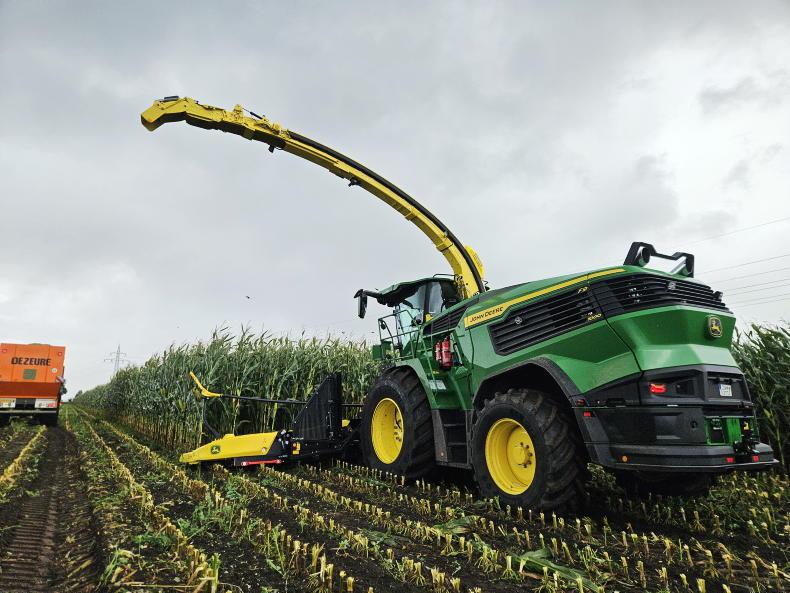

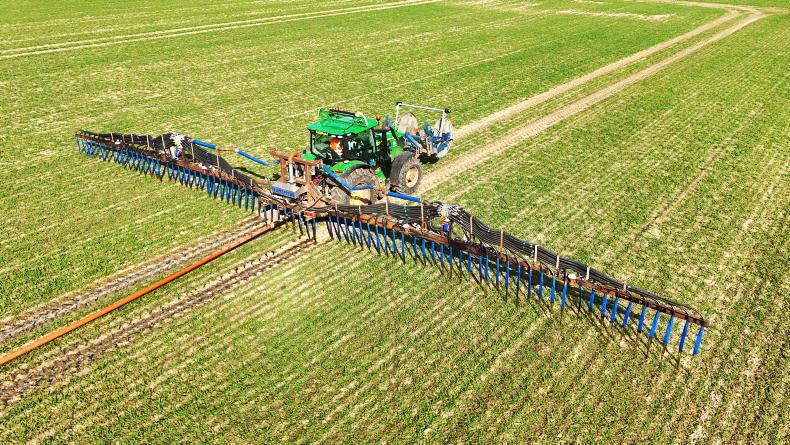
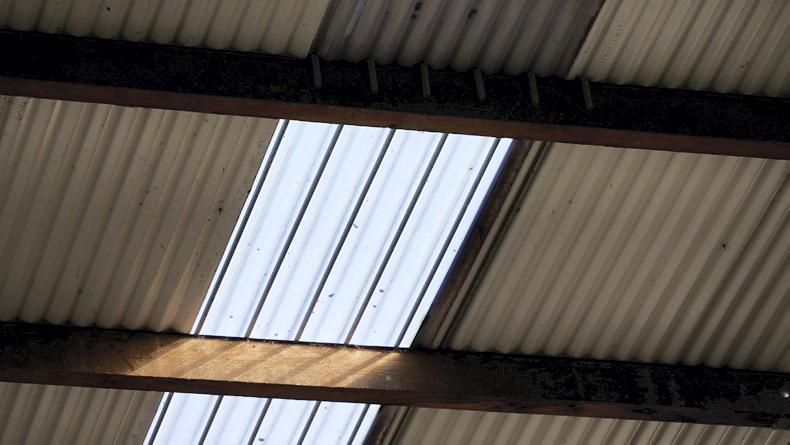
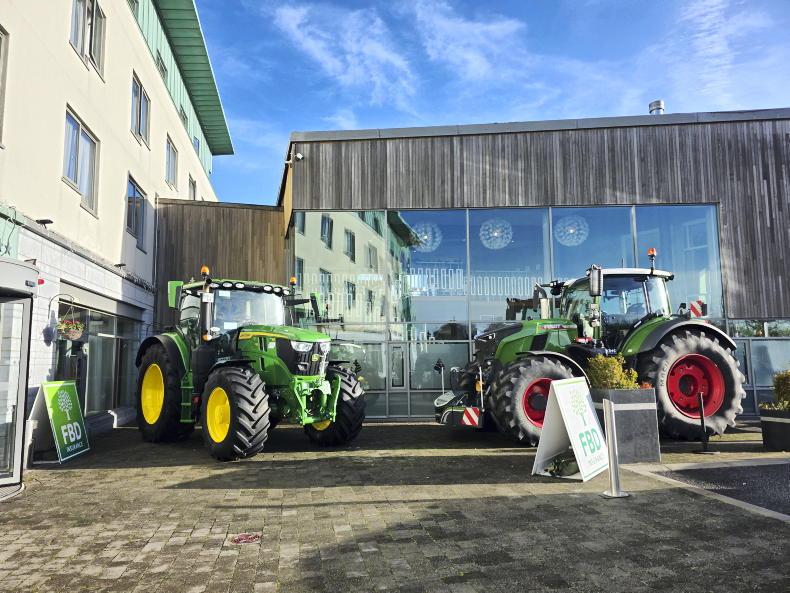
SHARING OPTIONS